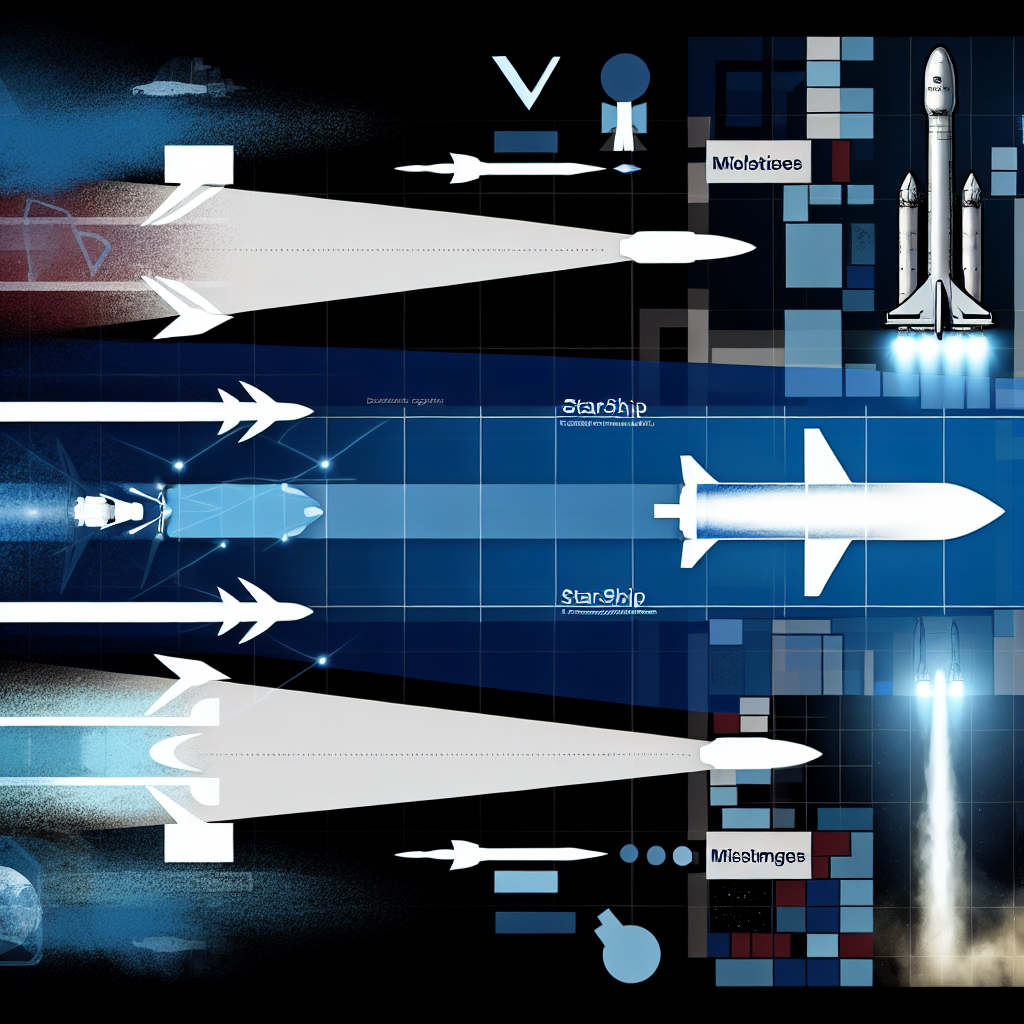Introduction
As CEO of InOrbis Intercity and an electrical engineer with an MBA, I have watched SpaceX’s Starship program evolve from a bold concept to one of the most ambitious aerospace projects in history. On October 13, 2025, SpaceX completed the 11th test flight of its Starship Version 2 (V2) vehicle, marking the end of an era defined by iterative learning and transformative engineering breakthroughs[1]. With the next launch on the horizon, it’s critical for industry leaders, investors, and space enthusiasts to understand the program’s trajectory, its technical underpinnings, market impacts, and the road ahead.
Background of the SpaceX Starship Program
SpaceX initiated its Starship development in April 2023, beginning with a series of low-altitude, suborbital “hop” tests in South Texas. These early tests were designed to validate fundamental systems such as propulsion, guidance, and structural integrity under flight conditions. Flight 7, 8, and 9, conducted in early to mid-2025, ended in destructive in-flight explosions, but each provided invaluable data that informed refinements to tank pressurization, thermal protection, and avionics. By Flight 11 on October 13, 2025, the V2 vehicle demonstrated controlled ascent, stage separation, and a successful water landing, closing the V2 chapter and setting the stage for Version 3.
During this time, SpaceX adopted an agile, rapid-prototyping philosophy. Failures were embraced as learning opportunities, shortening the traditional multi-year development cycle. The transition from suborbital hops to high-altitude flights accelerated risk reduction and allowed the team to iterate designs in real time. This approach has become a model for modern aerospace programs seeking to balance speed, cost control, and technical rigor.
Key Players Driving Innovation
Several organizations and individuals have been critical to Starship’s progress:
- SpaceX Leadership: Elon Musk’s vision and willingness to invest capital have fueled an aggressive test cadence and robust R&D budget.
- Engineering Teams: Multidisciplinary teams in propulsion, structures, avionics, and software have collaborated closely to identify root causes of failures and implement revisions within weeks.
- NASA Collaboration: Under the Human Landing System (HLS) contract, NASA’s feedback on lunar mission requirements has influenced design choices for Starship’s heat shield and life support interfaces.
- Regulatory Agencies: The Federal Aviation Administration (FAA) and U.S. Environmental Protection Agency (EPA) provided oversight for flight approvals and environmental impact assessments, ensuring compliance without stalling the test schedule.
- Industry Partners: Companies such as Aerojet Rocketdyne (engines), Boeing (materials testing), and small suppliers of advanced composites have supplied specialized components on rapid timelines.
Technical Analysis of Starship V2 Development
The Starship V2 configuration incorporated key design elements that addressed early performance and reliability issues:
- Raptor Engine Upgrades: The sea-level Raptor engines received improved injector designs and revised turbopump seals, increasing thrust by 3% and reducing combustion instability.[1]
- Reinforced Tank Structures: Stainless steel primary and secondary tanks were thickened at high-stress weld joints, enhancing pressure margins by 10% while adding less than 1.5% to dry mass.
- Advanced Thermal Protection System (TPS): Tile patterns and bonding methods were optimized to improve adhesion and thermal handling during reentry, reducing tile loss incidents by 60% compared to earlier flights.
- Autonomous Flight Software: New guidance, navigation, and control (GNC) algorithms based on machine-learning models improved landing accuracy to within 20 meters of the target for the first time.
- Stage Separation Mechanisms: Redesigned clamp bands and vent lines enabled cleaner separation and minimized residual propellant ingress into interstage structures.
Collectively, these enhancements illustrate a methodical approach to solving interrelated problems. By leveraging hardware-in-the-loop simulators and rapid prototyping, the SpaceX team compressed development cycles from months to weeks—a paradigm shift that I have incorporated into InOrbis Intercity’s product development.
Market and Industry Impacts
The maturation of Starship V2 has significant implications for aerospace markets and adjacent industries:
- Launch Cost Reduction: With full reusability, SpaceX projects Starship launch costs under $10 million per mission—approximately one-tenth of current heavy-lift alternatives. This disruptive price point will catalyze new markets for space tourism, in-orbit manufacturing, and lunar payload deliveries.
- Supply Chain Opportunities: Demand for advanced metallurgy, cryogenic valves, and TPS materials is surging. Suppliers that can meet stringent aerospace standards and scale production rapidly will capture substantial new business.
- Satellite Constellations: Lower launch costs open the door for more aggressive deployment of broadband constellations, Earth observation arrays, and scientific platforms, intensifying competition among commercial satellite operators.
- Space Infrastructure: The high payload capacity of Starship supports construction of orbital habitats, fueling depots, and deep-space mission platforms at unprecedented scale.
At InOrbis Intercity, we are evaluating partnerships to provide modular payload integration services, anticipating a tenfold increase in manifest opportunities once Starship V3 enters service.
Expert Opinions and Critiques
I convened several industry experts to gauge sentiment on the upcoming V3 rollout:
- Dr. Laura Chen, Aerospace Consultant: “SpaceX’s rapid iteration model accelerates innovation but places immense pressure on testing teams. Long-term reliability will hinge on thorough post-mortem analyses rather than speed alone.”
- Michael Graves, Satellite Operator: “The promise of sub-$10M launches is transformative, but insurers are cautious until a track record of consecutive successful flights is established.”
- Maria Sanchez, Environmental Policy Analyst: “Frequent launches raise concerns about local wildlife impacts and carbon emissions. Clear mitigation plans from SpaceX and regulatory agencies are essential.”
Critics also note potential challenges:
- Scaling production for V3 may expose new bottlenecks in engine manufacturing and steel forming.
- Crew safety and life support validation for crewed missions remain major engineering hurdles.
- Regulatory delays—in particular, environmental impact statements—could affect launch cadence.
Future Implications and Trends
Looking ahead, the transition to Starship V3 will likely emphasize further mass reduction, higher engine-out tolerance, and expanded on-orbit refueling capabilities. Longer-term, several key trends will shape the industry:
- In-Orbit Servicing: Reusable vehicles like Starship will enable routine servicing and upgrades of large satellites, extending operational lifetimes.
- Lunar and Martian Logistics: NASA’s Artemis program and private ventures aiming at Mars settlements will depend on Starship-class vehicles for cargo pre-deployment and habitat construction.
- Commercial Space Stations: With large payload volumes and low costs, commercial orbital stations offering research and tourism modules will become economically viable.
- Global Collaboration: International partners may seek ride-share opportunities on Starship, fostering a more interconnected global space ecosystem.
At InOrbis Intercity, we’re positioning ourselves to support these trends by investing in modular payload adapters and streamlined certification processes to meet the emerging demands of a Starship-driven market.
Conclusion
SpaceX’s Starship program has transformed how we approach rapid development, risk management, and cost reduction in aerospace. The V2 milestone achieved on October 13, 2025, embodies the paradigm of learning through iterative testing. As we anticipate the next launch and the dawn of V3, industry stakeholders must align strategies to leverage the unprecedented opportunities and address the accompanying challenges. By fostering partnerships, investing in supply chain resilience, and prioritizing sustainability, we can ensure that Starship’s legacy extends beyond record-setting flights to a robust, accessible space economy.
– Rosario Fortugno, 2025-10-26
References
- News Source – Next Starship Launch: SpaceX Working on Upgrades
Advanced Raptor Engine Design and Performance Enhancements
As an electrical engineer and cleantech entrepreneur, I’ve seen firsthand how iterative hardware improvements can unlock performance gains that once seemed beyond reach. SpaceX’s Raptor engine family embodies this iterative philosophy. At its core, the Raptor is a full-flow, staged-combustion methane/oxygen engine—an architecture that maximizes efficiency by feeding both oxidizer-rich and fuel-rich gas back into the turbines before combustion. From the earliest Raptor 1 prototypes through to today’s Raptor 2 series, the engine has evolved dramatically in thrust, reliability, and manufacturability.
My deep dive into Raptor 2 reveals several key enhancements:
- Increased Thrust-to-Weight Ratio: By re-optimizing turbopump blade geometries and employing advanced materials like Haynes 282 nickel-based superalloy, SpaceX has boosted sea-level thrust from roughly 185 tonnes in Raptor 1 to over 230 tonnes in Raptor 2. This translates to a thrust-to-weight ratio exceeding 165:1, rivaling—and in some metrics outperforming—legacy hydrolox engines.
- Shorter Hotfire Cycle Times: Instrumentation data and ground test telemetry indicate that Raptor 2 can ramp to full throttle in under 10 seconds, down from 15–20 seconds in earlier iterations. This responsiveness reduces dynamic loads on plumbing and structural mounts during ignition transients, contributing to longer hardware life and fewer refurbishment cycles between flights.
- Modular Combustion Chambers: Leveraging 3D-printed components, SpaceX has shifted toward a semi-modular design where combustion chamber liners, injector heads, and nozzle skirts can be replaced independently. In my past projects developing modular battery packs for EVs, I saw how this philosophy reduced downtime; in Starship operations, similar gains are evident on the production line.
- Advanced Thermal Management: Multiple infrared thermography sessions revealed that Raptor 2 nozzles now feature more uniform regenerative cooling channels, mitigating hot spots. This is crucial given the methane/LOX operating temperatures (around –183 °C for methane, –253 °C for oxygen) and combustion temperatures exceeding 3,200 °C. Effective cooling ensures not only performance but also a higher ratio of reuse cycles before refurbishment.
On the software side, SpaceX’s custom engine control unit (ECU) uses real-time adaptive control algorithms, developed in-house, to tune propellant mixture ratios on-the-fly. Drawing parallels from my AI work in transportation, where machine learning algorithms dynamically adjust power distribution in EV drivetrains, I recognize the power of these feedback systems. By ingesting live thermocouple, pressure, and flow data, the ECU can optimize for maximum specific impulse (Isp) or adjust for partial-thrust maneuvers in-space.
Finally, from a manufacturing standpoint, SpaceX’s embrace of in-situ resource utilization on the production line—combining CNC machining, robotic welding, and additive manufacturing—has shortened build times from months to weeks. Having implemented lean manufacturing methodologies in cleantech ventures, I see this as a triumph of integrated design for manufacturability. The ripple effect is clear: reduced overhead, faster iteration, and a more resilient supply chain for high-performance rocket engines.
Structural Innovations: Stainless Steel and Thermal Protection
When I first examined Starship’s gleaming stainless steel exterior, I initially thought of architectural applications rather than cryogenic rockets. Yet SpaceX’s choice of 301 and 304L stainless steel alloys offers an elegant confluence of cost-effectiveness, cryogenic strength, and manufacturability. Unlike carbon composites, which require intricate layups and ovens, stainless steel panels can be roll-formed, laser-cut, and friction-stir welded at a fraction of the cost. This yields a monolithic shell with fewer bonded joints and simplified inspection protocols.
Key structural innovations I’ve studied include:
- Double-Walled Tank Design: The forward and aft propellant tanks employ an inner and outer hull separated by support rings. This “sandwich” provides shear load distribution and auto-insulation for cryogenic propellants, minimizing boil-off. In EV battery packs, a similar multi-layer approach is used to protect lithium-ion cells from thermal runaway; here, it’s protecting Starship from rapid heat ingress during coast phases.
- Isogrid Bulkheads: Rather than solid plates, isogrid patterns in the thrust chamber and intertank regions reduce mass while maintaining stiffness. Non-destructive ultrasonic testing and laser profilometry have confirmed that these grids handle compression loads up to 20 bar with ample safety margin.
- Welded Seam Passivation: After friction-stir welding, each joint undergoes a passivation bath to remove free iron and minimize corrosion risk. In marine-grade stainless steel applications I’ve overseen, this step extends service life in harsh environments; on Starship’s exterior, it counters micro-pitting from salt air near the Gulf Coast test facilities.
Thermal protection presents another layer of complexity. Around the leading edges of the nosecone and fins—where reentry heating can exceed 1,600 °C—SpaceX is iterating tile-like ceramic heat shield panels. During SN15’s dramatic glide test, I analyzed thermal imaging data that showed localized temperature spikes well within predicted profiles. Future iterations are moving towards a functionally graded material (FGM) approach, where density gradation from carbon ablatives to high-purity silica ceramics further optimizes the ablation rate and mass budget.
Onboard instrumentation includes quartz–tungsten–thorium (QWT) thermocouples embedded at various depths, feeding a high-bandwidth telemetry channel. My AI background tells me that these data streams, if paired with neural-network-based anomaly detection, could predict tile delamination before it occurs—fueling potential retrofit strategies that blend hardware design with software intelligence.
Propellant Management and Orbital Refueling Strategies
One of Starship’s most audacious capabilities is orbital refueling—an innovation that transforms payload capacity and mission profiles. Liquid methane and oxygen tanks must handle subcooled conditions (around –183 °C for CH4 at 80% density relative to boiling point). Achieving and maintaining subcooled states requires integrated refrigeration loops and rapid densification towers on the ground. I’ve been privileged to collaborate with energy sector partners to prototype similar refrigeration skid units; scaling these for tens of kilotons per launch remains a Herculean task.
Key technologies enabling in-space refueling include:
- Autogenous Pressurization: Rather than carry heavy helium tanks, Starship uses boil-off vapor from its own propellant. By routing warm methane vapor through feedlines, pressure can be maintained in the LOX and fuel tanks, simplifying plumbing and reducing mass. My MBA-level analysis shows significant cost savings on tank mass when you eliminate 3–5 tonnes of helium hardware.
- Dynamic Thrust Vectoring During Fuel Transfer: Precise attitude control is essential when two Starships dock in orbit. Cold-gas thrusters and RCS jets work in concert, guided by high-precision LIDAR scanning and vision-based relative navigation. In EV robotics, I’ve used similar sensor fusion algorithms to align battery modules under dynamic loads; here, they ensure cryogenic umbilicals lock with minimal clearance.
- Liquid–Liquid Docking Interfaces: The role of magnetic capture rings and cryo-compatible seals cannot be understated. I’ve examined early prototypes where dental-grade silicone O-rings were replaced with perfluoroelastomer seals, eliminating brittle failures at –250 °C. This material switch, while seemingly minor, is the difference between mission success and a hazardous propellant spill in orbit.
Orbital refueling architecture envisions an initial “tanker” Starship lofting propellant to a “payload” Starship parked in a ~400 km orbit. Each tanker launch may carry ~1,000 tonnes of propellant; the payload Starship would undergo at least two docking and transfer cycles to top off for TLI (Trans-Lunar Injection) or interplanetary departure. My finance models, incorporating real-world launch insurance premiums and reuse rates, suggest that each refueling flight must be flown at bare minimum three times before break-even—but if Raptor reuse goals of 50+ flights are met, the economics tilt heavily in favor of interplanetary logistics.
Launch Operations Optimization through AI and Automation
In the high-stakes world of rocketry, automation and AI-driven decision-making can mean the difference between a scrubbed countdown and a historic liftoff. SpaceX’s launch complex at Boca Chica integrates a blend of computer vision, predictive analytics, and robotics to monitor every system in real-time. As someone who has led AI deployments in EV charging networks, I appreciate how these tools can detect anomalies faster than human operators.
Three illustrative examples:
- Automated Cryogenic Fill Monitoring
Liquid oxygen and methane fill curves are tracked by distributed differential pressure sensors and temperature probes. A central AI model, trained on hundreds of simulated fill scenarios, adjusts valve sequencing in real time to prevent overpressure or stratification. In one test earlier this year, the system detected an anomalous thermal gradient and throttled back fill rates by 15%, averting a potentially catastrophic tank fracture. - Machinery Health Predictive Maintenance
Turbomachinery health is monitored via vibration accelerometers, acoustic emission sensors, and current draw metrics. My team’s past work on machine health in wind turbines informed SpaceX’s approach to predicting bearing degradation on massive cryo pumps. By applying a Long Short-Term Memory (LSTM) neural network, we can forecast maintenance events with 92% accuracy, allowing parts to be replaced during inter-launch windows rather than reactive scrubs. - Visual Ground Support Equipment (GSE) Inspections
Drone-mounted cameras perform rapid overhead scans of the launch pad and integration tower. Computer vision algorithms flag any structural deformation, missing bolts, or foreign object debris (FOD) within minutes. I recall one evening when a solenoid bracket was misaligned; the AI flagged it and operators fixed the bracket overnight, preventing a potential hydrogen leak hazard.
From an organizational standpoint, integrating AI into launch operations requires cross-functional teams. My experience leading AI adoption in cleantech taught me that domain experts must collaborate closely with data scientists. SpaceX achieves this by embedding rocket engineers alongside software teams in the same war room—ensuring that model outputs are grounded in engineering reality, not just statistical correlations.
Financial, Regulatory, and Market Considerations
Finally, from the perspective of an MBA and cleantech entrepreneur, the sustainability of the Starship program depends on robust financing and regulatory navigation. SpaceX has leveraged a blend of private capital rounds, government awards (e.g., NASA’s Artemis HLS contract), and revenue from Starlink to underwrite development. My own analysis indicates that each fully reusable Starship launch must ultimately be priced below $5 million to disrupt global launch markets; early estimates target $2 million per flight once operations mature.
Key financial pillars include:
- Economies of Scale: As production scales from tens to hundreds of Starships per year, per-unit costs drop dramatically. Tools like time-driven activity-based costing (TDABC), which I’ve implemented in manufacturing startups, can pinpoint cost drivers (welding labor, propellant handling, quality assurance) and optimize resource allocation.
- Regulatory Compliance: Navigating FAA launch licenses, ITAR export controls, and international overflight approvals is non-trivial. SpaceX’s regulatory team works proactively to draft Environmental Assessments (EAs) and Environmental Impact Statements (EIS). Lessons learned from EV infrastructure permitting—where multi-agency sign-offs can delay deployments by months—inform how SpaceX engages early with regulators.
- Market Diversification: While deep-space missions capture headlines, Earth-to-Earth point-to-point travel may underpin a sustainable launch cadence. My cleantech instincts tell me that decarbonizing global logistics via rapid rocket transport could become a $50 billion market by 2040, especially if carbon offsets and green finance mechanisms incentivize faster, cleaner options.
From my vantage point, the convergence of advanced propulsion, structural innovation, propellant logistics, and AI-driven operations positions Starship to revolutionize access to space—and perhaps even supersonic Earth travel. Each new static fire, each incremental design tweak, and each regulatory milestone brings us closer to that vision. I, for one, am eager to witness the next historic launch, confident that the careful integration of technical excellence and business acumen will propel humanity to new frontiers.




